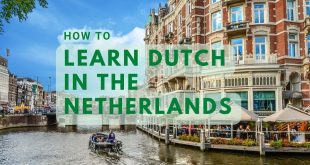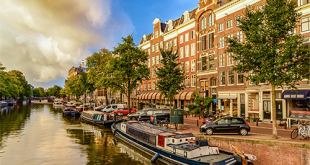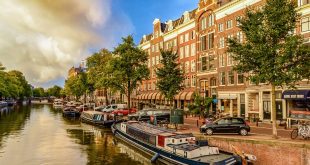Exploring another country is like entering a new and different way of life than what you’re used to. It’s an amazing experience on one hand, but it also has its share of difficulties – and the Netherlands is no exception. It’s a country known to be tolerant, progressive, open-minded which stands out for its picturesque canals, seaside fishing villages contrasting with its lively modern cities. To prepare you for your study life in the Netherlands, here’s a kind of “cultural cheat sheet” so you can get the most of the Dutch culture, customs and traditions.
Table of Contents
What are the Dutch people known for?
Wooden shoes, tulips, windmills, lace caps, are some well-known symbols of the Dutch culture. But there is so much more to know about the culture and traditions in the Netherlands.
Some more or less obvious such as the fact that they are strong advocates regarding the protection of the environment. Let’s start by some basic details about the Dutch society.
Population
The Netherlands is the 64th most populated country in the world, with a population of more than 17 million people. But it also has one of the highest population density in the world. One interesting fact about the Dutch people is that they are among the tallest people in Europe and have one of the longest average lifespans in the world.
Languages
The official language in the Netherlands is Dutch, that a vast majority of the population in the country speaks. There is a secondary language, the Frisian, spoken by a half-million people in the province of Friesland. Moreover, more than 90% of the Dutch people are fluent in English.
Economy
The Netherlands has an elaborate free-market economy, relying on agriculture, trade, and the service industries as its most important employment sectors. The Netherlands also has the highest rate of part-time workers in the European Union.
Safety
By international standards, the Netherlands is a safe country, with a very low violent crime rates. Of course, you still need to make sure to be careful like avoid putting your phone in your back pocket or to make sure your bike is locked before parking it. But just in case something happen, you can approach the police with confidence to get help.
Culture and traditions in the Netherlands: the Dutch lifestyle
Overall, the Dutch society is quite advanced, independent and mostly international. Having been an international trading hub for centuries, the society is more tolerant and open towards other cultures, thriving toward equality for everyone.
In their interaction with each other, the Dutch are very direct in their way of speaking. In return, you are also expected to voice your opinion, as well as your reasons for it, and to freely speak your mind. This directness often goes with direct eye contact. Therefore, it’s often seen as strange or rude to not make eye contact.
Moreover, there is this commitment to work altogether for the greater good. They call it the poldermodel, in which important decisions are taken after everyone has bee, able to voice their opinion and negotiations go on until they come up with an agreement that works for everybody.
Furthermore, in the culture of the Netherlands, people have a high regard for their privacy and usually leave each other alone. If someone wishes to talk to someone else, they take the initiative to do so. And if you want to build a stronger bond with the Dutch, prioritize asking questions and display your interest in learning about the Dutch culture and also the language.
Netherlands culture facts
The Netherlands has the highest number of art and historical museums in the world. It’s also the country of origin of Rembrandt, Vermeer, van Gogh, Mondrian and Steen. It’s no surprise then that the Netherlands also has an impressive collection of fine art.
One characteristic of the Netherlands’ landscape is its traditional houses. They are relatively small with large windows and prominent front doors. The interiors of the Dutch home reflect the exteriors: a bit overcrowded but orderly and clean.
Another fact related to the culture and traditions in the Netherlands is the fact that it is a hot spot for different kinds of events that the locals love to attend. Among the most popular annual events, there is the Maastricht Art Show in the first half of March, or the Amsterdam Roots Festival in June for music lovers.
And there is sport, that is a huge part of the life of many Dutch citizens. As a matter of fact, one Dutch out of three belongs to a sports club! And almost all Dutch people can ride a bike, swim and skate. Moreover, in order of popularity, the major sports in the Netherlands are football, cycling then speed skating. Football is a way of life and cycling is popular whether on open road, off trail or track!
The Dutch family culture
In the Dutch culture, parents are the heads of the family, the ones that define the rules. Families tend to be small ones, with only one or two children. It’s not rare that children discuss, argue and even disagree with their parents, since young people in the Netherlands are trained to form and voice up their own opinions.
Moreover, people are curious and talk freely about everything. They ask many questions and this way of life starts in the family unit. Dutch families like to do things together, especially on weekends. Upholding this work-life balance principle, people intentionally divide their time between all sorts of activities: sports, social clubs, cultural activities, visiting relatives and so on.
Traditions and culture in the Netherlands: food and culinary etiquette
The traditional Dutch cuisine is very simple and straightforward, but also nourishing with a lot of vegetables with a little meat or fish. It usually represents a mixture of various European cooking styles, but mostly have Italian Mediterranean, Chinese and Indonesian influences. In fact, you can find these influences at many Netherlands restaurants as well.
Dinner is usually the hot meal of the day, with traditionally two or three courses. It usually starts with a soup, then potatoes with a large portion of vegetables and a small portion of meat and followed by some pastries or cookies for dessert. Breakfast, on the other hand consists of a slice of bread with various toppings such as different cheeses, chocolate spread, peanut butter and treacle.
Lunch can include the same types of food as breakfast, most of the time, consists of open-faced sandwiches with cheeses and cold cuts. Moreover, cheese is a food staple in the Netherlands, with names like Gouda, Edam or Leyden that are famous worldwide. Other popular traditional food in the Netherlands include: salted herring, hagelslag (chocolate sprinkles), pffertjes (small, thick pancakes), stroopwafel (caramel waffle cookies) and French fries with mayonnaise.
Dutch customs and etiquette
The Dutch etiquette has a lot in common to what applies in the rest of the Western world. But there are some practices specific to the Dutch people, such as:
- Scheduling events like 6 weeks in advance! Dutch people live by schedules and are very strict regarding them.
- Shaking hands upon greeting and leaving. For people with whom they have a closer bond, it’s kissing the cheek three times, starting with the left cheek.
- Being very honest and straight to the point when talking with others. Some may call it rudeness; Dutch people consider it openness. And of course, it’s important to maintain strong eye contact in conversations.
- Not being surprised if the Dutch are impatient and rude on the road.
- Bringing a gift for the hostess when invited to a Dutch home. The most common and acceptable gifts include: flowers or a potted plant, quality chocolates, or a book.




 Aljawaz Your guide to study abroad
Aljawaz Your guide to study abroad














